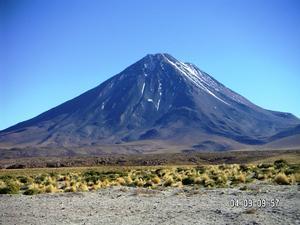Advertisement
Published: January 8th 2006

 volcano Licancabur
volcano Licancabur
The majestic and mystic volcano Licancabur (5,916 meters above sea level) is only 40 kilometers away from San Pedro de Atacama. The name means 'village hill', and it was venerated by the Incas, who carried out ceremonies and left offerings in the crater of its top. After staying a week in groovy backpackers gathering spot San Pedro de Atacama we decided to do a tour to Bolivia. We chose Turismo Colque as they promised us that we could get a ride to Potosi. I wanted to do more than just a usual trip to lagoons and Salar de Uyuni. Early in the morning we said goodbye to Chano and squeezed into a van full of Japanese, Englishmen, Germans and even a couple from Poland. Hearing all those stories about beautiful landscape, a very severe frost and altitude sickness, we couldn’t wait to get on a 4WD at the Bolivian border... And we could wait to get back to San Pedro too!!!! it's true what they say about Bolivia, everything it's true. And Boliva is a dream, a perfect dream, but it could also be a nightmare.
Advertisement
Tot: 0.107s; Tpl: 0.039s; cc: 9; qc: 56; dbt: 0.0456s; 1; m:domysql w:travelblog (10.17.0.13); sld: 1;
; mem: 1.1mb

 volcano Licancabur
volcano Licancabur














































